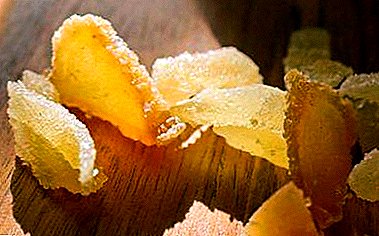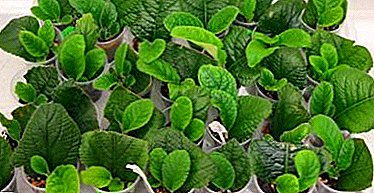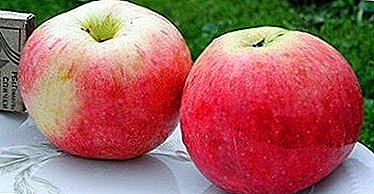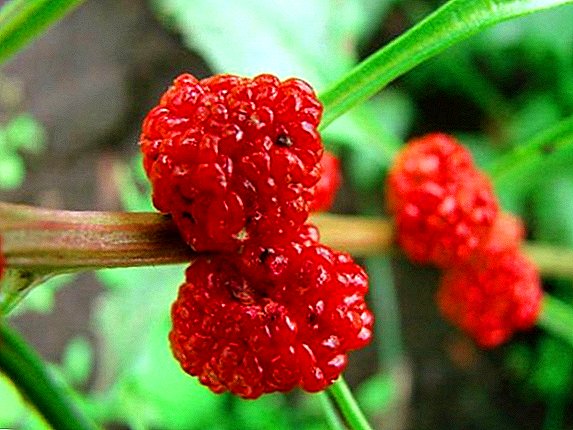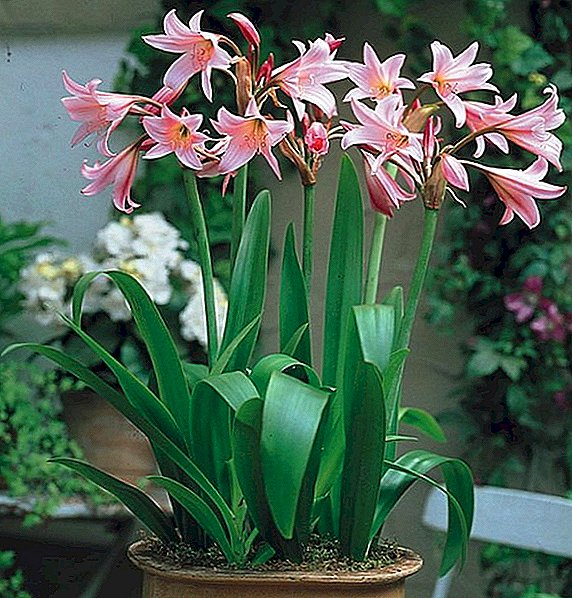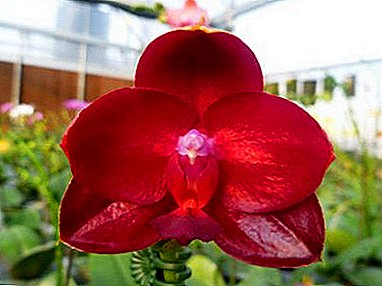
If life is boring and monotonous, you want a bright exotic, you can make friends with orchids. And in order to add mood and increase vitality, no better tropical miracle than a maroon orchid was found. Elegant, bright, seductive flowers will enliven and add joy to your home. In this article we consider the varieties of burgundy orchids, care for them, how to feed and replant, as well as what pests should be wary.
definition
Burgundy orchid is a hybrid, the result of several transitions, belongs to the ancient family of orchids, a genus of epiphytes. They grow on the stumps and trunks of trees, in gorges of rocks, in mountain forests, on rocks. The birthplace of this beautiful flower is Southeast Asia, any tropical terrain.
Appearance Description
The leaves are large and glossy. The petals of the flower are bright - maroon, have several shades: from maroon to red. Petals are round, grow up to 5-6 cm. Peduncle large enough, it can grow to half a meter.
Species and their photos
The varieties of burgundy orchids include:
Red

Very fragile, elite flower. The stem is long and thin. The leaves are fleshy, dense, bright green, grow up to 40-45 cm. The inflorescences may consist of one or several flowers, sometimes there are about 40.
Miniature

Rare species, usually with 2 peduncles. The leaves are dense, wax, grow up to 30-35 cm. The flower itself is very similar to a butterfly - thin, bright, elegant.
Breeding history
The “primary sources” of the bright miracle of the bordeaux orchid is a night flower - a moth discovered on Ambon by Professor Blum in the 18th century. Centuries later, beautiful "butterflies" filled our homes and apartments. Burgundy orchid is a hybrid variety, perfectly adapted to our conditions, climate. Today this variety is very popular due to its bright colors and unpretentiousness.
Step-by-step instruction
In general, the cultivation and reproduction of orchids occurs on the same principle, since all these plants come from the tropics. But the care of hybrid varieties need to be treated with great attention.
By care
Best of all, the flower feels on the western or eastern windows. In winter, when there is a lack of light, additional lighting is used to increase the day length to 10-12 hours. If there is enough light, the leaves and roots get sick, then watering should be moderate - once in 7-8 days. In summer, burgundy orchid is watered once a week. But it is better to focus on the state of the substrate. If the soil is dry, only watering is required. Water only with warm, separated or rainy water.
Orchids also like a warm shower. You can water the method of immersion - when lowering the pot in a bucket with water for 20 minutes, the orchid will receive the necessary moisture. Then allow the orchids to settle well, so that the excess liquid flows through the drainage holes in the water collection pan.
Important! It is recommended to pour out excess water from the pan in order not to soak the roots. It causes rotting roots. After watering with cotton swabs, it is necessary to dry the bosoms of the leaves in order to prevent rotting.
The maroon orchid loves heat and humidityas its tropical ancestors: temperature - 24 - 29 ° C during the day. At night - not less than 15 - 16 ° C. The temperature difference should not exceed 9 - 10 ° C. Humidity average - 50 - 70%.
The soil for burgundy orchids should be free and light, its composition:
- Drainage - pieces of expanded clay, pebbles, are placed on the bottom of the pot. Medium pieces of pine bark, peeled and well disinfected (boil the substrate for several minutes).
- Charcoal.
- Moss - sphagnum.
A transparent plastic pot of medium size with drainage holes is required., the holes are not only on the bottom, but also on the sides of the pot. The height of the pot and the width in diameter should be the same.
On top dressing
 It is recommended not to feed burgundy orchid more than once a week. It is better to buy special fertilizers in stores with the obligatory note: "For orchids." As a rule, top dressing is performed simultaneously with irrigation, therefore the necessary nutrition evenly reaches its goal. During the growth period, the following composition is used for top dressing (1: 3: 1 ratio): calcium nitrate; nitrogen; magnesium sulfate.
It is recommended not to feed burgundy orchid more than once a week. It is better to buy special fertilizers in stores with the obligatory note: "For orchids." As a rule, top dressing is performed simultaneously with irrigation, therefore the necessary nutrition evenly reaches its goal. During the growth period, the following composition is used for top dressing (1: 3: 1 ratio): calcium nitrate; nitrogen; magnesium sulfate.
In winter, when the lighting decreases and the temperature decreases, the amount of fertilizer with nitrogen decreases 1.5-2 times. The main thing - do no harm, you can cause intoxication and death of orchids.
By transplant
Transplantation using the transshipment method is the most painless method:
- soak the substrate well, immerse it in water for 30-40 minutes using a solution of epin;
- carefully separate the roots from the old substrate;
- rinse the roots with warm water;
- using a clean tool cut rotten and dead roots;
- place the slices with cinnamon or roasted charcoal to disinfect;
- dry the renewed orchid well.
Breeding
Burgundy orchid usually reproduces only "kids" - small growths.
Tip! It is better to multiply orchids from February to May - June. The procedure for the separation of "children": choose an adult orchid with a good overgrown root, large leaves. Flowers should already bloom, and the flower should be fresh.
With a knife on the peduncle, the tip is incised to the top of the “sleeping” kidney, the place of the incision is sprinkled with charcoal or cinnamon. We transplant the new sprout into the prepared small pots with the necessary substrate. Watering should be stopped for 4-5 days, the plant needs to recover.
Pests and diseases
- Spider mite - The most frequent "pest" for burgundy orchids, it multiplies very quickly and almost eats the plant. From any ticks and other pests, flower growers are recommended to immediately spray orchids with a special solution or soak them with insect roots for 15 minutes and quarantine (for at least a month).
- Different rot, especially in summer, affect the roots and leaves of a weakened orchid, the flower may rot, die. If you see root rotting, you need to immediately save the flower: transplant it, carefully cut out all rotten roots with a knife. "Wounds" should be decontaminated, sprinkled with cinnamon and lubricated with oil.
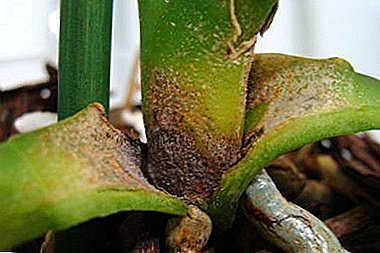 Fungus in the bark, on the leaves. An urgent transplant is needed here. Infected substrate must be changed. The pot must be disinfected, as well as the window sill or the place where the pots are.
Fungus in the bark, on the leaves. An urgent transplant is needed here. Infected substrate must be changed. The pot must be disinfected, as well as the window sill or the place where the pots are.Use a spray solution of phytosporin or any other antifungal drug. Dosage drugs should be very modest, because the drug, if it is wrong, adversely affects the root system as a whole. To disinfect the roots, they can be treated with 3% hydrogen peroxide.
- Yellowing leaves - Orchid "overheated" in the sun. Move it to darker places. The fall of the buds and leaves is a little light. If it is autumn or winter, use additional lamps, increase the light day.
Attention! Beware of drafts. Do not place pots over heating batteries.
Conclusion
Burgundy orchids have many varieties, but they are all in great demand and are loved by collectors. These wonderful hybrids feel good with the right care. They bloom several times a year, bloom for a long time: solemnly and festively, they surprise, delight, give a subtle scent of beautiful bloom!


 Fungus in the bark, on the leaves. An urgent transplant is needed here. Infected substrate must be changed. The pot must be disinfected, as well as the window sill or the place where the pots are.
Fungus in the bark, on the leaves. An urgent transplant is needed here. Infected substrate must be changed. The pot must be disinfected, as well as the window sill or the place where the pots are.